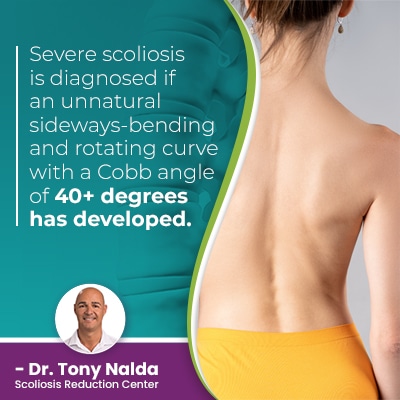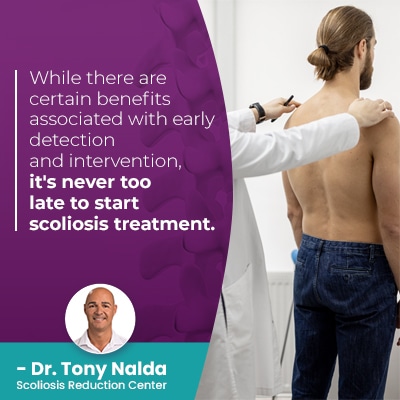Severe Scoliosis Treatment: Is It Ever Too Late to Start?

As an incurable progressive condition, scoliosis treatment is about managing an ongoing condition for the best quality of life. The more severe scoliosis is, the more likely it is to continue progressing, and while there are no treatment guarantees, it's never too late to work towards improvement.
Scoliosis is a spinal condition that can range from mild scoliosis to moderate scoliosis, severe and very severe scoliosis. As a progressive condition whose nature is to get worse, regardless of type or severity, the best time to start treatment is always now.
Scoliosis severity is determined by a measurement known as Cobb angle, so let's start with how the measurement is taken.
Table of Contents
Scoliosis Severity: Cobb Angle Measurement
There are a number of spinal conditions that cause a loss of healthy spinal curves and disrupts the spine's neutral alignment.
There are some characteristics that set scoliosis apart, making it particularly complex to treat.
As a progressive condition, the nature of scoliosis is to get worse over time, and this means the size of the unnatural sideways-bending and twisting spinal curvature is going to increase.
As scoliosis progresses and becomes more severe, it's becoming more complex to treat, hence the benefit of a proactive treatment approach that works towards preventing progression.
Part of diagnosing scoliosis involves further classifying conditions based on a number of key factors, one of which is condition severity.
Condition severity is determined during X-ray by a patient's Cobb angle; this is measured by drawing lines from the tops and bottoms of the curve's most-tilted vertebrae at the curve's apex, and the resulting angle is expressed in degrees.
The higher a patient's Cobb angle, the more unnaturally tilted the vertebrae are, and the more severe the condition:
- Mild scoliosis involves Cobb angle measurements between 10 and 25 degrees
- Moderate scoliosis is diagnosed with Cobb angle measurements of between 25 and 40 degrees
- Severe scoliosis is diagnosed at 40+ degrees and very-severe scoliosis at 80+ degrees
The more severe a condition is, the more likely it is that its effects are going to be noticeable, so let's compare the effects of severe scoliosis with moderate and severe.
And remember, as a progressive condition, where scoliosis is at the time of diagnosis doesn't mean that's where it will stay.
What is Severe Scoliosis?
 Severe scoliosis is diagnosed if an unnatural sideways-bending and rotating curve with a Cobb angle of 40+ degrees has developed.
Severe scoliosis is diagnosed if an unnatural sideways-bending and rotating curve with a Cobb angle of 40+ degrees has developed.
Severe scoliosis is likely to have noticeable effects because a significant amount of progression has already occurred, and as scoliosis progresses and becomes more severe, it's becoming more complex to treat, hence the benefit of proactive treatment.
Postural Effects
The main symptoms of scoliosis in children involve postural changes, and this is due to the condition's uneven forces disrupting the body's overall symmetry, and the more severe a patient's scoliosis, the more overt those changes are going to be.
In addition to postural changes, at the severe level, noticeable disruptions to balance, coordination, and gait are also common as the body's center of gravity is disrupted.
Postural changes associated with severe scoliosis can include:
The head uncentered over the torso
- An uneven eyeline
- Uneven shoulders
- Uneven shoulder blades
- The development of a rib cage arch
- Uneven hips
- Arms and legs that appear to hang at different lengths
- A prominent lean to one side
A child whose clothes suddenly seem ill-fitting with necklines pulling to one side and arm sleeves being longer on one side can be experiencing asymmetrical postural changes.
Adults with scoliosis also experience postural changes, but the main symptom of adult scoliosis is pain.
Severe Scoliosis Pain
Scoliosis doesn't become a compressive condition until skeletal maturity has been reached, and it's compression (uneven pressure) of the spine and its surrounding muscles and nerves that causes the majority of condition-related pain.
Severe scoliosis pain can involve muscle pain, back pain, and pain that radiates into the extremities due to nerve compression.
Back pain is generally felt in the area surrounding the affected spinal section, and when nerve compression is involved, nerve pain can radiate into the extremities and throughout the body.
At the severe level, even for adolescents for whom the condition is not yet compressive, there is likely to be varying degrees of muscle and back pain.
When it comes to chronic pain management, the best approach is proactive treatment that addresses the underlying cause of the pain: the condition itself.
Pain gets worse alongside compression because the condition is getting more severe and its effects more noticeable.
Severe Scoliosis Treatment
While there are certain benefits associated with early detection and intervention, it's never too late to start scoliosis treatment.
As a progressive condition, scoliosis is incurable, so treatment is about how best to manage an ongoing condition; scoliosis can be highly treatable.
With severe scoliosis in children, the goal is to work towards a significant curvature reduction and hold it there despite the constant trigger of growth: counteracting the condition's progressive nature.
The goal of treating severe scoliosis in adult patients differs somewhat because the progressive rate is slower and spinal degeneration is a factor; the two main condition types to affect adults are idiopathic and degenerative scoliosis.
The focus of adult scoliosis treatment is still to reduce the curve, but more so back to where it was prior to becoming painful, rather than a significant counteractive reduction that's the goal of childhood scoliosis treatment.
Here at the Scoliosis Reduction Center®, patients benefit from conservative treatment options that involve chiropractic care, physical therapy, scoliosis exercises, corrective bracing, and rehabilitation.
Untreated Scoliosis
 Untreated scoliosis is virtually guaranteed to continue to get worse, and the more severe scoliosis is, the more unstable and unbalanced the spine is, making it more vulnerable to degenerative changes and continued progression.
Untreated scoliosis is virtually guaranteed to continue to get worse, and the more severe scoliosis is, the more unstable and unbalanced the spine is, making it more vulnerable to degenerative changes and continued progression.
Untreated scoliosis is going to become more complex to treat over time; the spine gets increasingly rigid, condition effects become more established, and the spine and body is going to be less responsive to treatment.
Untreated severe scoliosis is also the most likely to cause related complications: digestive issues, lung impairment, headaches/migraines, and sleep problems.
Digestive issues can occur because of structural changes, movement changes, and nerve issues due to compression.
Breathing difficulties aren't a common complication, are associated with severe and very severe scoliosis, and are often only noticeable to those who place higher than average demands on their respiratory systems, like professional athletes.
Mainly associated with thoracic scoliosis, a rib cage arch can develop, and this impacts the space available for the lungs to function optimally within.
Headaches and migraines can be common due to the irregularity in cerebrospinal fluid flow that scoliosis can cause; the unnatural spinal curvature can interrupt the flow between the spine and brain,. and this can cause headaches that can reach migraine status.
Sleep problems can develop for a number of reasons including back pain making it difficult to get comfortable, and for those wearing a scoliosis brace that needs to be worn at night, getting comfortable can be particularly challenging.
Conclusion
It's never too late to start scoliosis treatment; while there are benefits associated with starting treatment while conditions are mild and moderate, improvements can still be made with my severe scoliosis patients.
Here at the Center, my patients benefit from a nonsurgical alternative that chooses to treat scoliosis proactively and conservatively; this approach is safer and less invasive than traditional spinal fusion surgery.
Patients suffering from scoliosis can experience a wide range of symptoms as spinal conditions can affect the spine, its surrounding muscles and spinal nerves, and the entire body.
Scoliosis introduces a lot of uneven forces to the body that can affect appearance, movement, and sensation; spinal health is important for overall quality of life.
Severe scoliosis patients are likely to notice the condition's effects, and in adolescent idiopathic scoliosis, these will include postural changes, and in adult idiopathic scoliosis and degenerative scoliosis, the main effect will be pain as the condition is compressive and the spine becomes increasingly unbalanced an unstable.
Many cases of scoliosis don't require surgical treatment, and the best way to relieve pain caused by scoliosis is to treat it proactively.
Surgical procedures come with their share of risks and potential complications, and successful chiropractic clinics that specialize in scoliosis have been producing impressive results.
When it comes to correcting scoliosis and impacting curve progression in a way that's sustainable, an integrative approach that combines chiropractic care, physical therapy, exercise, corrective bracing, and rehabilitation, conservative treatment options can be powerful.
It's never too late to start scoliosis treatment because while there is no way to cure scoliosis, the best time to start treatment, regardless of condition type or severity, is always now.
Dr. Tony Nalda
DOCTOR OF CHIROPRACTIC
After receiving an undergraduate degree in psychology and his Doctorate of Chiropractic from Life University, Dr. Nalda settled in Celebration, Florida and proceeded to build one of Central Florida’s most successful chiropractic clinics.
His experience with patients suffering from scoliosis, and the confusion and frustration they faced, led him to seek a specialty in scoliosis care. In 2006 he completed his Intensive Care Certification from CLEAR Institute, a leading scoliosis educational and certification center.
About Dr. Tony Nalda
 Ready to explore scoliosis treatment? Contact Us Now
Ready to explore scoliosis treatment? Contact Us Now





